Pruning rosemary is not difficult, and doing it the right way will ensure a healthy and highly productive plant. In this post, you’ll learn why, when, and exactly how to trim it back, step by step.
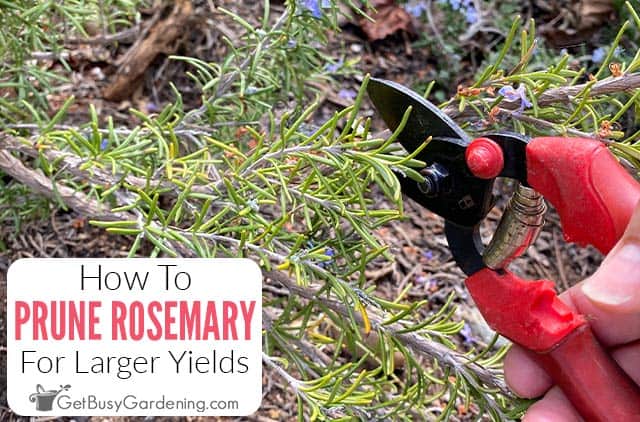
Rosemary is a hardy herb that can often be left to its own devices. However, when performing light or heavy prunes, cutting the right parts is crucial.
In this guide, I’ll share my top tips for pruning rosemary. I’ll also delve into why, when, and how you should cut it back.
Covering everything from what tools you’ll need, to optimal angles for trimming, I’ll teach you all you need to know.
Should You Trim Rosemary Plants?
While pruning rosemary isn’t an essential part of successful care, trimming yours regularly will help to maintain its shape, and encourage fresh new shoots.
Larger bushes can look overgrown and woody, or end up with bare spots over time if you leave them completely untouched.
So, for best results, it’s wise to cut it back on a regular basis.
Related Post: Pruning Plants: The Complete Step-By-Step Guide

Why Prune Rosemary?
The main benefits for pruning rosemary are to keep it healthy, bushy, and highly productive.
Once they become overly woody, they may struggle to resprout, even in optimal conditions. Regular trimming will create a compact shape, and result in higher yields.
Removing dead or diseased branches will invigorate them and improve airflow, which can prevent fungus and disease issues.
When To Prune Rosemary
The exact timing for when to prune rosemary depends on where you live. In warmer regions, the best time is late winter through early summer.
Tender stems are more vulnerable to the cold, so stop trimming four to six weeks before the first frost.
For maximum production in a cold climate, start cutting it back in late spring, and continue until the weather cools down in the fall.

Tools For Trimming Rosemary
Most parts of a rosemary plant are too tough to pinch off with your fingers, so you’re going to need some pruning tools to get the job done.
To cut back thick branches, use standard shears or heavy-duty ones for best results.
For established shrubs, using a hedge shears or an electric trimmer will make the job easier and faster.
I also like to use a lopper or pruning saw to remove any large or very thick, woody branches.
Whatever tools you choose, just ensure that they are freshly sharpened and sterilized to avoid any damage.
Related Post: Propagating Rosemary By Rooting Cuttings In Water Or Soil
Rosemary Pruning Techniques
There are two basic techniques that you can use to prune your rosemary. They are, trimming back large stems and branches, and removing new tips.
Trimming Back Stems & Branches
You can trim off long stems as needed to shape the plant and maintain its size. It’s also good to remove any dead or diseased branches on a regular basis.
Be careful not to cut back too far into old wood, as doing so may prevent new growth.
For best results, start at the top and center, and work your way down and around the sides. This will give you a better view of what needs to be removed as you work.
Removing The New Tips
Removing the new tips while pruning rosemary encourages branching, resulting in higher yields. To do this, pinch the tender tops, or trim them off with precision shears.
This works especially well when the plant is young, as it often results in multiple stems branching out just below each cut.
Related Post: Harvesting Rosemary: When & How To Pick The Leaves & Sprigs
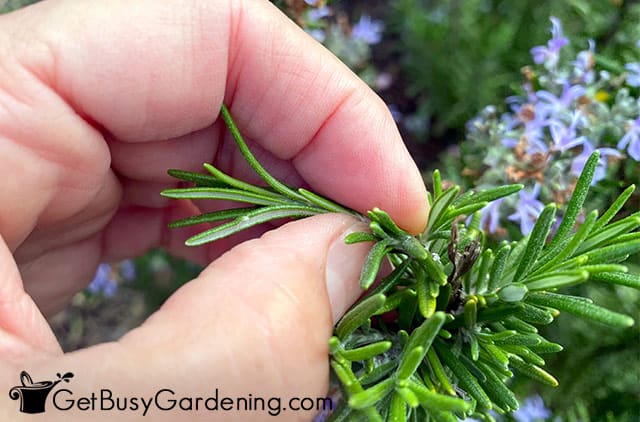
How To Prune Rosemary
The best way to increase yield and prevent your rosemary from becoming large and leggy is to trim it back regularly. Below I’ll give you the steps for the two most common techniques.
1. How To Prune Rosemary To Promote Growth
Use this pruning method to promote fresh new tender shoots, and increase the yield of your rosemary.
This works the best for young plants, and for people who want to get the most from their shorter gardening season.
Step 1. Deadhead the flowers first – Pinch out any dead or faded flowers with your fingers, or use a pair of sharp snips to cut them off. Hedge shears or an electric tool will work best for larger shrubs.
Step 2. Remove broken or diseased branches – Use your heavy-duty or regular hand shears to remove these branches. This will make room for fresh, healthy stems, and prevent further damage.
Step 3. Cut the outer stems back – Locate the longest outer stems and cut each one back by approximately 1 inch. Make your cuts at a 45 degree angle to prevent water from pooling in the wound.
Step 4. Repeat for the inside stems – Move to the older inside stems, and trim these back by a similar amount.
Step 5. Check your progress regularly – To avoid over-pruning or creating an irregular shape, take a step back after every few cuts to make sure they are evenly spaced around the plant.
2. How To Prune Overgrown Rosemary Bushes
If your rosemary bushes are overgrown, and begin to look leggy or woody, you’ll need to do a harder pruning.
You can be quite aggressive with trimming them back, but never cut below the last set of leaves, or remove more than ⅓ the plant at one time.
Step 1. Get rid of any dead wood – Before performing a heavy prune, remove any obviously dead wood so you can get a better look at your rosemary bush.
To do this, simply snip it down to the main stem. You may need a lopper or a pruning saw to remove thick or stubborn branches.
Step 2. Cut the plant back – You can trim woody branches back by up to 50%, as long as there are still several sets of leaves left below your cuts.
Step 3. Check for any entwined branches – Carefully examine your shrub for any entwined or crossing branches. Remove the worst looking ones to increase airflow and reduce the risk of damage and disease.
Step 4. Follow up with a light prune – Heavy prunes shouldn’t be performed regularly. But you should follow up with light trimming, as outlined in the steps above, to keep your rosemary healthy and highly productive.
FAQs About Pruning Rosemary
In the following section, I’ll address the most common questions people have about pruning rosemary. If you can’t find your answer here, leave a comment below.
How far back can I prune rosemary?
You can prune rosemary back pretty far, but never remove more than one third of the size of the plant at a time. Also, avoid cutting woody branches back below the last set of leaves.
How do you cut rosemary without killing the plant?
To avoid killing your rosemary, never cut back more than a third of its full size at one time. Over-pruning or cutting back too far into the woody branches could result in a completely barren or dead plant.
How do you trim rosemary so it keeps growing?
To trim rosemary so it keeps growing, only take a few inches off at a time, and never cut it back too far. Pinching the tips regularly will ensure a vigorous and bushy plant.
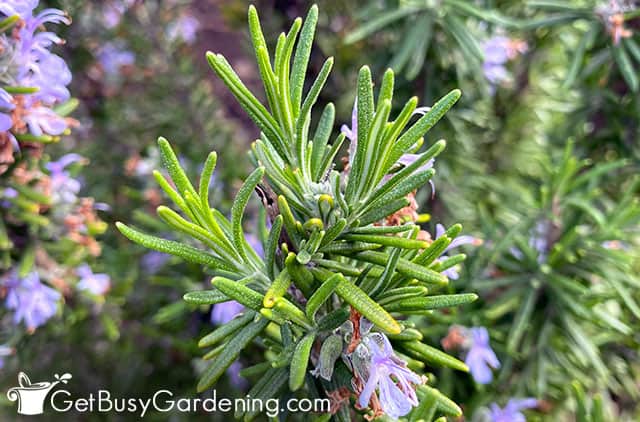
Does rosemary regrow after cutting?
Yes, rosemary will regrow after cutting, as long as it’s done properly. Stick to trimming the green stems only, and prune it regularly for the best success.
Can rosemary plants be cut back hard?
Mature rosemary plants can be cut back hard. But you should leave this intense pruning to the late winter or early spring months to prevent frost damage to the tender new shoots.
Pruning rosemary isn’t difficult, and it’s the best way to promote larger yields and keep your plant healthy. With regular trimming, it will be in peak condition for years to come.
More About Pruning Plants
- How To Prune Basil The Right Way
- Pruning Lavender: A Step-By-Step Guide
- How To Prune Chives & Deadhead The Flowers
- How To Prune Hydrangeas Step By Step
Share your tips for how to prune rosemary in the comments section below.
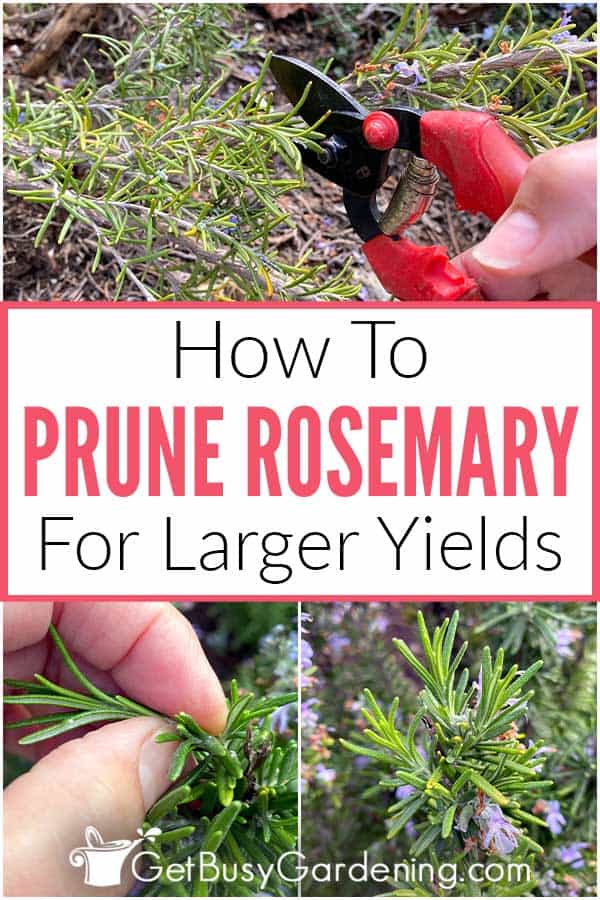

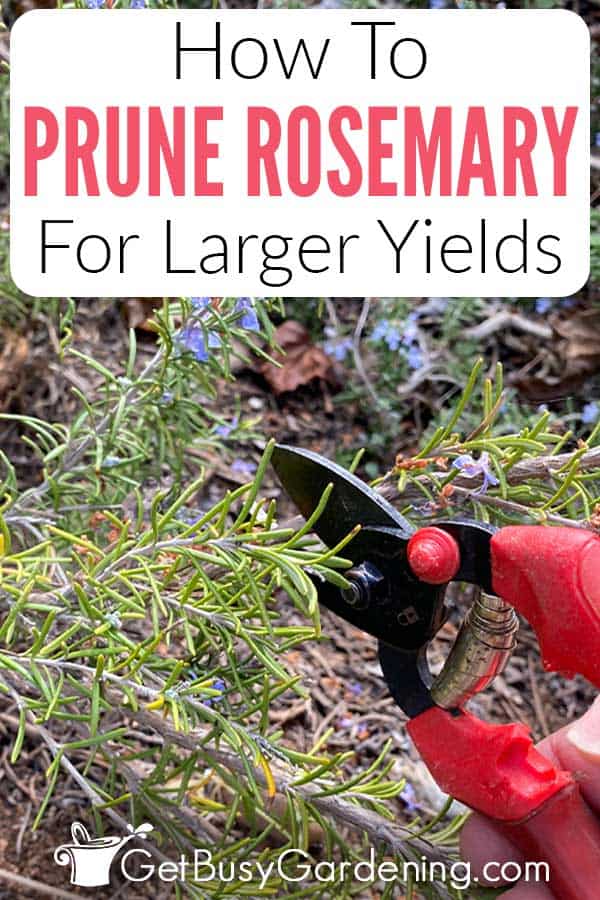

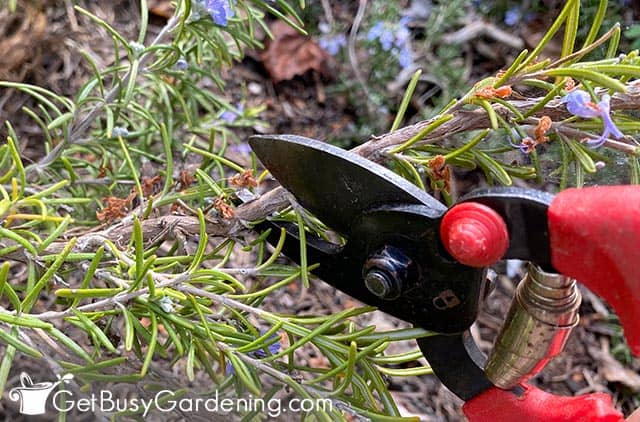
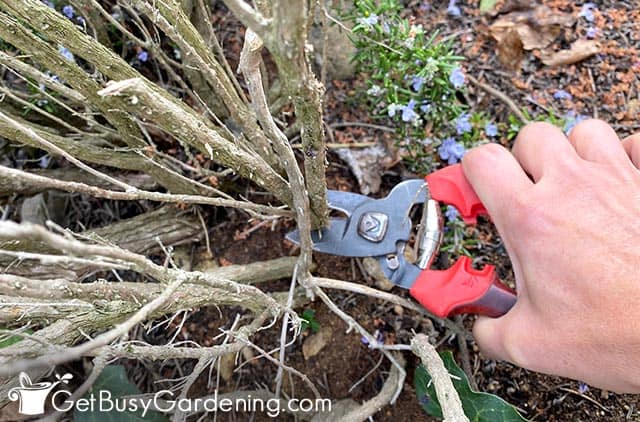

Shanna says
Part of my rosemary bush died over the winter. There is one section of green near the back. It it best to cut away all the dead parts (live in S AZ so rare hard freezes)
Thank you!
Amy Andrychowicz says
Yes, cut off all of the dead foliage and branches to open up your rosemary plant and trigger new, bushy growth. Good luck, I hope it comes back for you!
Kel says
thanks for the article! It was very helpful.
What can you do with a plant if you let it get over a foot tall, it started getting woody and then pruned (most of the stems) back by half? I did that, and it sits there looking happy with its woody stems, but not really growing. 😬
Amy Andrychowicz says
Unfortunately, rosemary will not grow back from the woody stems. So, if you cut into the wood back below the last live leaves/green stems, then it’s likely not going to grow back in those areas.